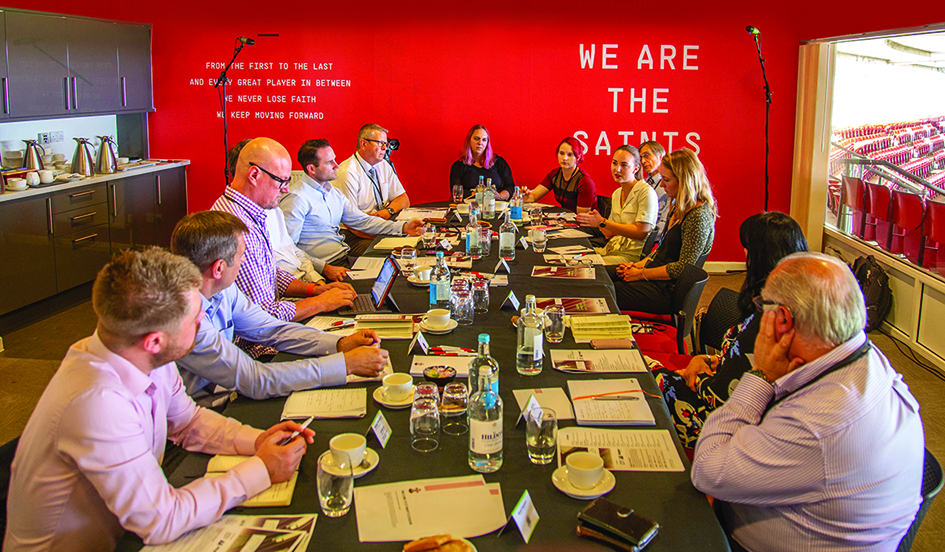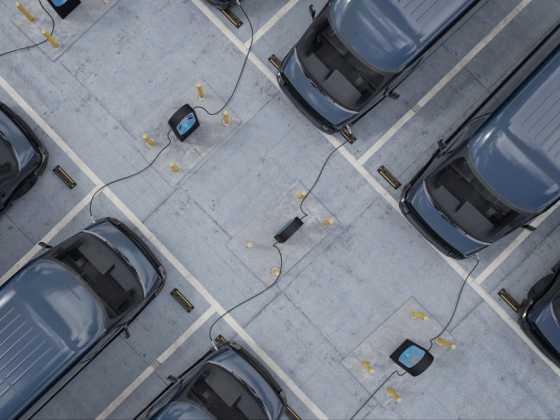Roundtable: Lowering the emissions of commercial vehicles

There is an appetite amongst commercial vehicle operators to go green, but the government must provide a clear strategy for cleaning up larger vehicles to give fleet operators a clear path forward. This was the message from the GreenFleet Roundtable, which took place at St Mary’s Football Stadium in Southampton on 16 July
Despite clear progress in the consumer and fleet market, there is still a long way to go to clean up heavy commercial vehicles.
Delegates at GreenFleet’s latest roundtable explored the barriers to cleaner commercial vehicle adoption and how to overcome them, as well as what businesses can do now whilst the commercial vehicle market plays catch up.
For many, changing to a cleaner vehicle is a standard part of business practice, but making the leap to zero emissions still requires a leap of faith; a leap some have yet to wrestle with, despite mounting pressure from central and local government.
There is a genuine lack of heavy goods vehicles that utilise cleaner technologies and so complying with the requirement to have Euro 6 vehicles is seen by many to be as far as they can go.
Changing regulations
The day began with the attendees looking at the rapidly changing political and regulatory frameworks that require action on commercial transport emissions.
Air quality is getting worse with increased levels of nitrous oxide, carbon dioxide and particulate matter causing ever increasing respiratory problems. Recent media coverage of particulates from tyres and brakes has once more raised the profile of clean air and the unintended consequences of moving people and products about.
Rebecca Kite from the FTA gave us an insight into the legislative and policy frameworks in place that are likely to impact on commercial fleets.
In July 2017 the government introduced the concept of clean air zones in a number of UK cities. Southampton, amongst others, has agreed to implement changes but not introduce a clean air zone.
Rebecca informed us that the FTA has been pushing to make such zones as small as possible and introduced as late as possible to assist businesses in meeting obligations for commercial fleets.
In July 2018 the UK Government launched it’s Road to Zero strategy; its plans for the decarbonisation of transport. The FTA challenged the document as it didn’t define what constitutes an ultra low emission truck. The government is developing a definition and it is felt that this will help vehicle manufacturers deliver vehicles of the required specification.
Sarah Maxwell from the City of London gave an overview of the challenges she faces in meeting the challenges presented by the Ultra Low Emission Zone in London.
Whilst the City of London covers a very small geographical area, the need to obtain vehicles of the correct size, that meet the need to be zero emissions is leading her to buy smaller vehicles that will do the job, rather than the larger vehicles which have yet to hit the market.
As has been seen at many low emission exhibitions and motor shows, manufacturers are gearing up to provide product that meets legislative standards by 2021 but the reality is that implementation of long term solutions is being held up by this long lead time for new products. This situation is further compounded by the current long lead times, of up to eighteen months for existing electric vehicles. It almost feels like the UK market reached the tipping point for electric vehicle uptake and may lose traction if supply continues to be a problem, causing fleet managers to settle for replacement vehicles with traditional internal combustion engines.
Energy sources
The roundtable explored the need to couple the use of electric vehicles with renewable energy. Nadia Smith from the Renewable Energy Association agreed that without renewable energy, electric vehicles do not deliver the possible benefits but said that one size does not fit all when using renewables for transport.
Sarah Maxwell illustrated this point brilliantly outlining how the City of London has massive challenges making solar work due to the height of buildings and shadows cast.
Paul Hancock from Bournemouth, Poole and Christchurch said: “Not all necessary policy makers are joined up to make a low carbon transport infrastructure work.” It is critical that policies are aligned and work to deliver systemic change at scale and pace.
Michael Wilmshurst from Hitachi Capital Vehicle Solutions said that getting renewables into vehicles and back out, via vehicle to grid technology, is the optimum way to fully build the case. It was recognised by all that the withdrawal of reduction in feed in tariff significantly undermined the challenge of justifying a business case for alternative fuelled vehicles. We asked how a government can declare a climate emergency but at the same time reduce subsidy to encourage the uptake of renewables and low emission vehicles.
The alignment of such policies is key to ensuring that implementation by business is effective and efficient.
Vehicle usage
Paul Hancock from Bournemouth, Poole and Christchurch rightly stated that there is a need to review the whole transport network to reduce the number of vehicles in fleets, the miles driven and to encourage alternatives. For local authorities and public sector organisations it is a standard practice when undertaking vehicle procurement to establish the vehicle requirement, what will it be used for and what are the clean alternatives, before any vehicle purchase is considered.
Joe Leduc from Agility Fuel Solutions believes that the slow rate of uptake of alternative fuels is in part because it requires fleets to change their behaviour, something that needs justification and for many organisations, getting broad stakeholder buy-in can feel like fighting a losing battle.
Heavy goods vehicles
There was a discussion about whether the necessary technology is available in the HGV market or not.
Mick Cook from Babcock said that the electric vehicle isn’t technically capable of working at range above 18 tonnes and this was sadly widely accepted. Despite Tesla announcing the electric lorry none are currently available.
We explored the place for alternatives in the HGV sector such as CNG / LNG and Hydrogen.
The panel agreed that there are still many misconceptions about alternative fuels which need to be tackled through education, learning from others, and hands-on experience. Companies like Waitrose operating with gas can only help support adoption and may in time give them a competitive advantage.
Assurance schemes have a big part to play, in giving certainty to buyers. The EST and LowCVP both work with the FTA to share best practice
CNG suffers from a perception of failure following a stalled uptake in the late 80s and early 90s. CNG also comes with safety and security challenges due to its potentially explosive nature. However, natural gas is no different to many other transport fuels in that regard.
Brian Avery from Surrey and Sussex Police reminded us that with cobalt and lithium as key components of batteries, few transport solutions come without an environmental impact. Whilst it was agreed that this was the case the potential for the circular economy and reuse of second hand batteries has its place in decarbonising, as a storage medium for renewables.
We discussed at length the need to give input and feedback to the government on the disjointed nature of policies and implementation dates, especially as batteries and HGV solutions are pretty much unavailable at present. It was agreed that unified responses and lobbying would be optimal. The SMMT, the FTA and REA have a collective opportunity to influence policy. However, business and government seem to believe that the other is responsible for the implementation of solutions.
Finance options
Leasing or capital purchase turned out to be a very interesting discussion. As battery electric vehicles are in short supply, companies that traditionally buy their fleet solutions outright have started to lease for a short period until new stock is available to buy.
Outright purchase was a firm favourite for those seeking to use specialist vehicles as they cover low mileage and are able to be ‘sweated’ over an extended period.
In the afternoon, Joe Leduc from Agility Fuel Systems set out that they are technology agnostic but seek to supply transport solutions that improve air quality and make an environmental improvement.
The business case for vehicles doing more than 100,000 miles a year is clear and alternative fuels such as CNG/LNG and hydrogen can work in the right application.
Joe rightly pointed out that our transport history does not dictate our future and that we have an opportunity to learn from the mistakes of the past. The previous work with CNG/LNG fuelled vehicles was done as dual-fuel aftermarket conversions and the smaller players were not readily available to service the product. The new CNG/LNG vehicles are OEM manufactured, dedicated gas powertrains and well-supported which offers customers improved reliability.
Speaking of the future, we received a comprehensive update on what the future looks like from Michael at Hitachi. What was of particular interest was the proposition to work with Hitachi to install refuelling capacity in depots as part of the leasing solution.
There was a certain amount of frustration that change is happening all too slowly but Nadia Smith of the REA rightly urged us to remember that progress has been made over the last five years and that change is happening. The pace of change is slower than the market requires, and businesses can only buy what manufacturers produce.
Rob Ellis of Ringway knew exactly what was required: “We need a fuel that will enable us to carry the same load, for the same distance, at a similar cost.” Joe Leduc was delighted to say that natural gas ticks all those boxes.
We concluded the day by identifying that to increase the speed of change and improve clean commercial vehicle uptake, the government needs to provide a clear strategy for HGVs, while the vehicle manufacturers must keep up with demand and make sure the vehicles are available. It feels like there is a great deal still to do.
To view the video of the roundtable event, including individual interviews, visit www.greenfleet.net/roundtables






